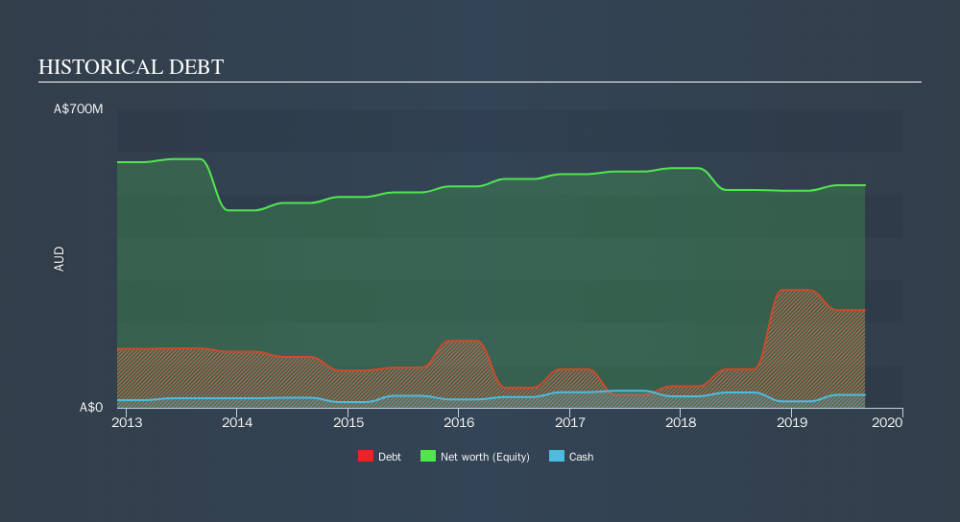Does Australian Pharmaceutical Industries (ASX:API) Have A Healthy Balance Sheet?

The external fund manager backed by Berkshire Hathaway's Charlie Munger, Li Lu, makes no bones about it when he says 'The biggest investment risk is not the volatility of prices, but whether you will suffer a permanent loss of capital. So it seems the smart money knows that debt - which is usually involved in bankruptcies - is a very important factor, when you assess how risky a company is. As with many other companies Australian Pharmaceutical Industries Limited (ASX:API) makes use of debt. But the more important question is: how much risk is that debt creating?
Why Does Debt Bring Risk?
Generally speaking, debt only becomes a real problem when a company can't easily pay it off, either by raising capital or with its own cash flow. Ultimately, if the company can't fulfill its legal obligations to repay debt, shareholders could walk away with nothing. However, a more frequent (but still costly) occurrence is where a company must issue shares at bargain-basement prices, permanently diluting shareholders, just to shore up its balance sheet. Of course, plenty of companies use debt to fund growth, without any negative consequences. The first step when considering a company's debt levels is to consider its cash and debt together.
Check out our latest analysis for Australian Pharmaceutical Industries
What Is Australian Pharmaceutical Industries's Net Debt?
As you can see below, at the end of August 2019, Australian Pharmaceutical Industries had AU$228.8m of debt, up from AU$100.0m a year ago. Click the image for more detail. However, it also had AU$30.2m in cash, and so its net debt is AU$198.6m.
How Strong Is Australian Pharmaceutical Industries's Balance Sheet?
According to the last reported balance sheet, Australian Pharmaceutical Industries had liabilities of AU$887.5m due within 12 months, and liabilities of AU$255.4m due beyond 12 months. On the other hand, it had cash of AU$30.2m and AU$657.9m worth of receivables due within a year. So its liabilities outweigh the sum of its cash and (near-term) receivables by AU$454.8m.
This deficit is considerable relative to its market capitalization of AU$687.1m, so it does suggest shareholders should keep an eye on Australian Pharmaceutical Industries's use of debt. This suggests shareholders would heavily diluted if the company needed to shore up its balance sheet in a hurry.
In order to size up a company's debt relative to its earnings, we calculate its net debt divided by its earnings before interest, tax, depreciation, and amortization (EBITDA) and its earnings before interest and tax (EBIT) divided by its interest expense (its interest cover). The advantage of this approach is that we take into account both the absolute quantum of debt (with net debt to EBITDA) and the actual interest expenses associated with that debt (with its interest cover ratio).
Australian Pharmaceutical Industries's net debt to EBITDA ratio of about 1.9 suggests only moderate use of debt. And its commanding EBIT of 14.0 times its interest expense, implies the debt load is as light as a peacock feather. If Australian Pharmaceutical Industries can keep growing EBIT at last year's rate of 15% over the last year, then it will find its debt load easier to manage. The balance sheet is clearly the area to focus on when you are analysing debt. But ultimately the future profitability of the business will decide if Australian Pharmaceutical Industries can strengthen its balance sheet over time. So if you want to see what the professionals think, you might find this free report on analyst profit forecasts to be interesting.
Finally, while the tax-man may adore accounting profits, lenders only accept cold hard cash. So it's worth checking how much of that EBIT is backed by free cash flow. In the last three years, Australian Pharmaceutical Industries's free cash flow amounted to 29% of its EBIT, less than we'd expect. That weak cash conversion makes it more difficult to handle indebtedness.
Our View
When it comes to the balance sheet, the standout positive for Australian Pharmaceutical Industries was the fact that it seems able to cover its interest expense with its EBIT confidently. However, our other observations weren't so heartening. For instance it seems like it has to struggle a bit to handle its total liabilities. We would also note that Healthcare industry companies like Australian Pharmaceutical Industries commonly do use debt without problems. When we consider all the factors mentioned above, we do feel a bit cautious about Australian Pharmaceutical Industries's use of debt. While debt does have its upside in higher potential returns, we think shareholders should definitely consider how debt levels might make the stock more risky. We'd be motivated to research the stock further if we found out that Australian Pharmaceutical Industries insiders have bought shares recently. If you would too, then you're in luck, since today we're sharing our list of reported insider transactions for free.
At the end of the day, it's often better to focus on companies that are free from net debt. You can access our special list of such companies (all with a track record of profit growth). It's free.
We aim to bring you long-term focused research analysis driven by fundamental data. Note that our analysis may not factor in the latest price-sensitive company announcements or qualitative material.
If you spot an error that warrants correction, please contact the editor at editorial-team@simplywallst.com. This article by Simply Wall St is general in nature. It does not constitute a recommendation to buy or sell any stock, and does not take account of your objectives, or your financial situation. Simply Wall St has no position in the stocks mentioned. Thank you for reading.

